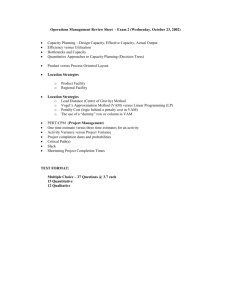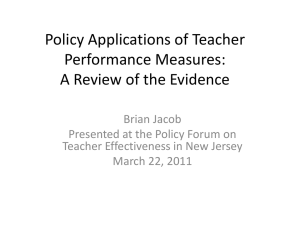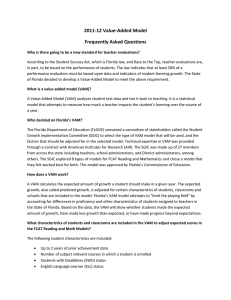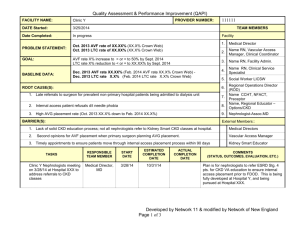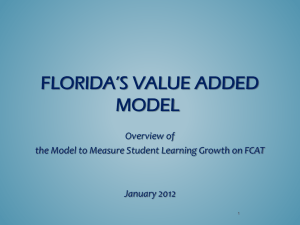Procedures for Using VAM Data to Determine Points toward Unified
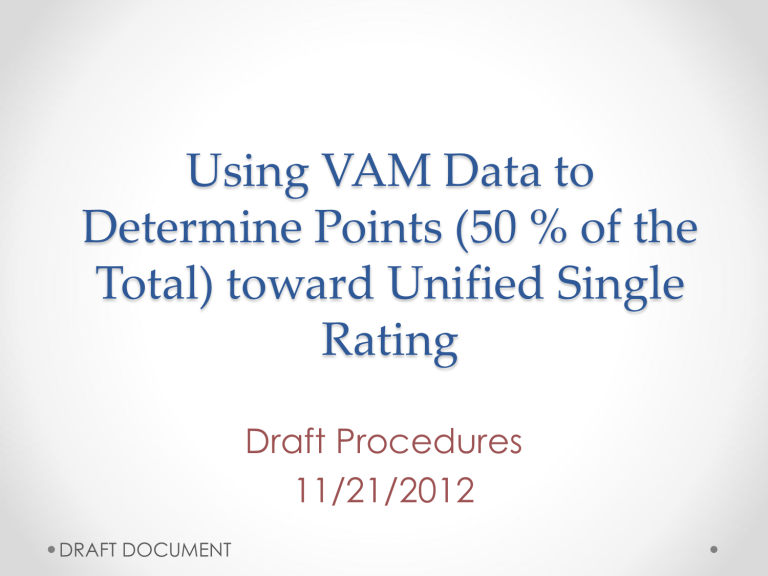
Using VAM Data to
Determine Points (50 % of the
Total) toward Unified Single
Rating
DRAFT DOCUMENT
Draft Procedures
11/21/2012
Teacher Groups
• Core: Teachers who taught Reading,
Mathematics, or Algebra and have 2011-12
VAM Data
• Non-Core: Teachers of Other Subjects with
Students who Have 2011-12 VAM Data in
Reading
• School-wide: School-based Teachers without
Students who Have 2011-12 VAM Data in
Reading, Mathematics, or Algebra
• District-wide: Non-school based Teachers without Students who Have 2011-12 VAM Data in Reading
DRAFT DOCUMENT
Standardizing and Aggregating
VAM Outcomes
1. Standardize the 2012 VAM scores and their standard errors using the districtwide mean and standard deviations of teacher VAM estimates weighted by the number of students within each subject area and grade level.
2. Aggregate the standardized reading and/or mathematics VAM scores and their standard errors across grades to the teacher level for Category
CORE and NON-CORE teachers.
3. For school-wide and District-wide teachers, aggregate standardized reading and mathematics VAM scores and their standard errors to the school or District level respectively.
DRAFT DOCUMENT
Determining Classification Categories
For each level of aggregation (teacher, school, or District), follow the procedure below.
1. If the sum of the standardized VAM score and 1.96 times its standard error is less than zero, assign Category 1.
(Under the normality assumption, one is 97.5% confident that the VAM score is below the districtwide average.)
2. If the sum of the standardized VAM score and 1 standard error is less than zero, assign Category 2 .
(One is 84% confident that the VAM score is below the districtwide average.)
3. If the difference between the standardized VAM score and 1.96 times its standard error is greater than zero, assign Category 4 . (One is 97.5% confident that the VAM score is above the districtwide average.)
4. Assign category 3 to all other teachers (or schools).
DRAFT DOCUMENT
Determining School-Wide Categories
1. School-wide categories are determined in both reading and mathematics (or Algebra).
2. For all schools the procedure described above is used to determine the school-wide category based on reading VAM scores and their standard errors.
3. For elementary, middle schools and K-8 centers, the procedure is used with the mathematics and
Algebra VAM scores separately (when available) and their standard errors. For high schools, it is used with the Algebra VAM scores and their standard errors.
DRAFT DOCUMENT
Assigning Points
• The 0-50 interval for the points based on the VAM scores is split into four subintervals (categories) of equal lengths:
Category 1 0-12.5
Category 2
Category 3
Category 4
12.5-25
25-37.5
37.5-50
• Once the classification category is determined based on the VAM scores and their standard errors, assign the maximum possible numbers of points for the particular category.
DRAFT DOCUMENT
Assigning Points (continued)
Teacher Groups CORE and NON-CORE
• Assign points to each VAM classification category as follows:
1 12.5 points
2
3
4
25 points
37.5 points
50 points
• For teachers who have points in more than one
subject area, calculate the weighted average of the assigned points using the numbers of students as weights.
DRAFT DOCUMENT
Assigning Points (continued)
Teacher Group School –wide
1. Determine points based on the school classification category in reading and mathematics (or Algebra) as described previously.
2. For schools that have both mathematics and algebra points (middle, K-8), find the weighted average of points based on the number of students used to calculate VAM scores.
3. Compare the numbers of points assigned to schools based on reading vs. based on mathematics/algebra and assign the higher number to affected teachers.
Teacher Group District-wide
Assign points based on the District classification category determined using the reading VAM scores and their standard errors as described previously.
DRAFT DOCUMENT
Special Considerations
If any of the points assigned to teachers in groups CORE or NON-CORE are based on fewer than 10 students, compare that number of points with the number assigned to the school-wide group, and assign the higher number .
DRAFT DOCUMENT
DRAFT DOCUMENT
DRAFT DOCUMENT
DRAFT DOCUMENT
DRAFT DOCUMENT
DRAFT DOCUMENT
DRAFT DOCUMENT
DRAFT DOCUMENT
DRAFT DOCUMENT
